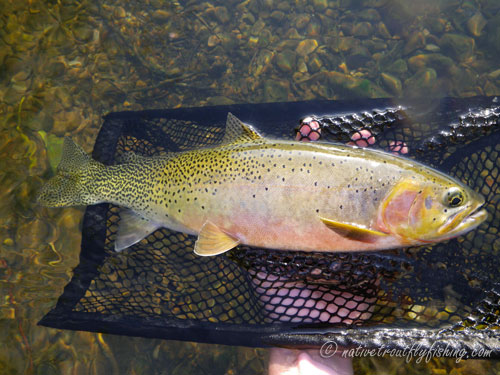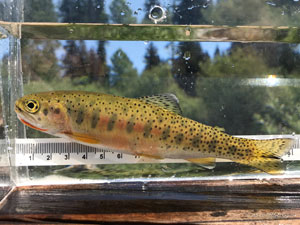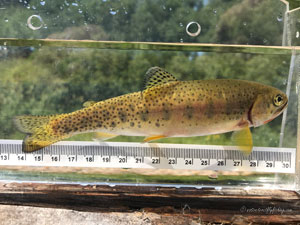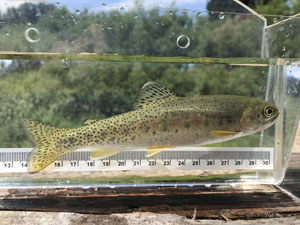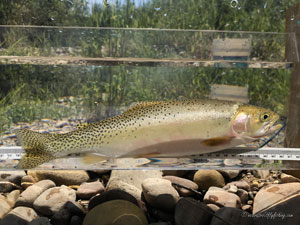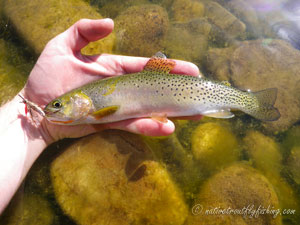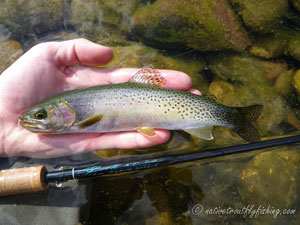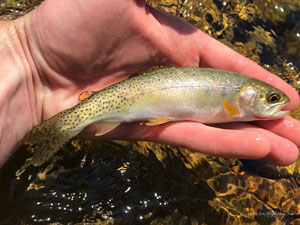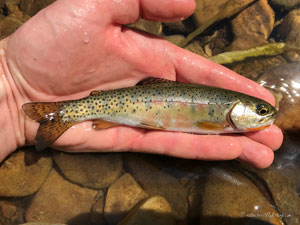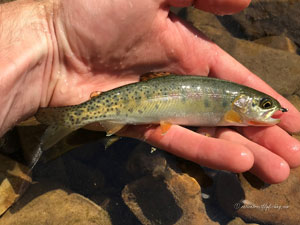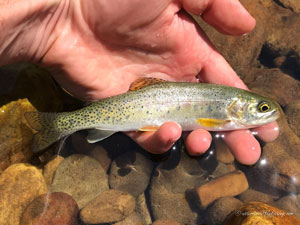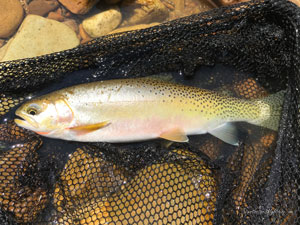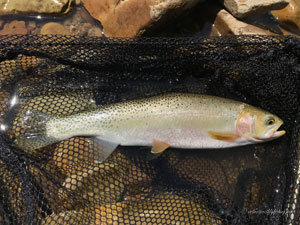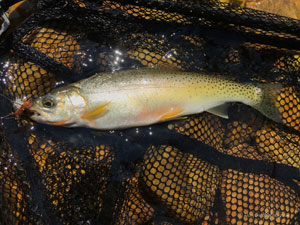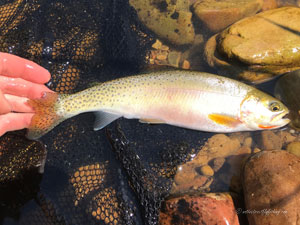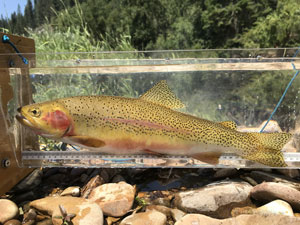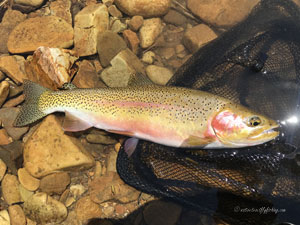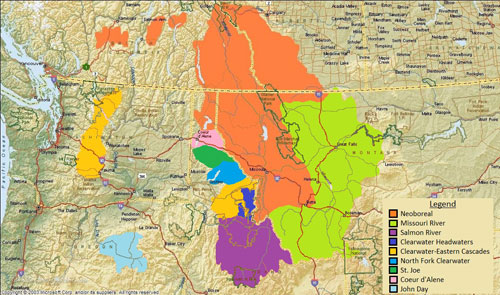Coeur d'Alene Westslope Cutthroat
Oncorhynchus lewisi ssp.
A fluvial Coeur d'Alene Westslope Cutthroat from an Idaho stream.
Introduction
The Coeur d’Alene River Westslope Cutthroat Trout are native to the Coeur d’ Alene River drainage in Northern Idaho. Oddly, Cutthroat from the Neoboreal subspecies is found in the lower reaches of the Coeur d’Alene and St. Joe watersheds and while it is assumed that these fish originated from hatchery stocking, their origins are uncertain (Young et al. 2018). Originally, the Coeur d’Alene Westslope Cutthroat were lumped the rest of the Westslope Cutthroat as a single subspecies Oncorhynchus clarkii lewisi based primarily on morphological characteristics (Behnke 1992, Behnke 2002). However, recent genetic evidence indicates that the Coeur d’Alene Westslope Cutthroat are distinct enough warrant subspecies status (Trotter et al. 2018, Young et al. 2018).
Life History Information
The Coeur d’Alene River Westslope Cutthroat exhibit stream resident, fluvial (river migrant) and possibly adfluvial (stream to lake migrant) life histories, although it is unclear whether adfluvial fish represent the Coeur d’Alene or Neoboreal subspecies. Stream resident fish are common in smaller tributaries to the Coeur d’Alene River and are primarily drift feeders, preying on aquatic and terrestrial invertebrates and generally reach a maximum size of 12” (30 cm). While stream resident fish typically show little movement, fluvial fish migrate throughout the Coeur d’Alene watershed and primarily spawn in tributaries. However, fluvial Cutthroat typically will spend the entire summer with a small area, often holding in one pool for two months (Dupont et al. 2008). However, when water temperatures exceed 72° F (22° C) Coeur d’Alene Westslope Cutthroat, especially those over 12” (30 cm) will migrate to downstream areas with cooler water temperatures, often to side-channel areas or near the mouths of tributaries (Stevens and Dupont 2011). These Cutthroat prey on a variety of aquatic and terrestrial invertebrates, as well as fish and salmon eggs when available, and reach a maximum size of approximately 22” (56 cm). During October and November, these Cutthroat will migrate up to 10.5 miles (17 km) into overwintering pools where they typically remain until March. Fluvial Cutthroat from the lower North Fork Coeur d’Alene typically make the longest spawning migrations in the watershed, with distances of up to 45 miles (72 km) observed (Dupont et al. 2008). These Cutthroat generally spawn for the first time at age-2 for males and age-3 for females, with spawning starting when water temperatures reach 43° F to 48° F (6.1° C to 8.8° C) (Trotter et al. 2008). In the Coeur d’Alene watershed this means that spawning typically takes place between mid-April and early-May, with most fish moving in and out of their spawning areas within a two-week period and returning to their home ranges by June (Dupont et al. 2008).
Adfluvial juveniles typically emerge around two months after being spawned and spend 1 to 4 years in tributaries before migrating to the lake at a size of 7” to 9” (18 cm to 23 cm) (Trotter 2008). Adfluvial Cutthroat migrate downstream into Lake Coeur d’Alene in June, where they spend 2 to 3 years foraging prior to migrating upstream to spawn at age-5 to age-6, although age-3 spawners have been observed as well (Trotter 2008). Upstream migrations into the river observed between December and April and the spawn timing and size at maturity are thought to be similar to that of fluvial fish (Behnke 2002, Dupont et al. 2008).
Status
The Coeur d’Alene Westslope Cutthroat Trout along with all other Westslope Cutthroat in the United States were petitioned to be listed as under the Endangered Species Act in 1997 due to declines across their native range, but it was determined that listed status was not warranted (USFWS 1996, USFWS 2003). The Coeur d’Alene River Westslope Cutthroat are still present throughout most of their native range, although they certainly have been impacted by a number of human caused factors, their populations are beginning to recover. The primary impacts to the Coeur d’Alene Westslope Cutthroat have been from habitat destruction due to logging, pollution from mining, overfishing and the introduction of non-native salmonids.
The South Fork of the Coeur d’Alene River in particular has an extensive history or mining dating back to the 1880’s. This mining and the associated smelting resulted in high levels of toxic heavy metals, which made much of the South Fork and lower mainstem Coeur d’Alene uninhabitable for fish. The elevated heavy metals found in aquatic invertebrates in the South Fork Coeur d’Alene have been shown to result in internal damage to Cutthroat and result in lower growth rates and reduced survival (Farag et al. 1999). Currently, the lower portion of the South Fork Coeur d’Alene floodplain is a superfund cleanup site and efforts are starting to pay off as fish populations are showing a sign of recovering. However, many of the Cutthroat in the South Fork and lower Coeur d’Alene River have blackened tails, which is believed to be caused by the elevated heavy metal concentrations (Dupont et al. 2008).
Historically the only native salmonids in the Coeur d’Alene drainage were Cutthroat, Interior Bull Trout, Mountain Whitefish and Pygmy Whitefish. Several species of non-native salmonids have been introduced throughout the range of these Cutthroat, including Chinook and Kokanee Salmon, Brook Trout and hatchery Rainbow Trout. Fortunately, the impacts of hybridization with hatchery Rainbow Trout has not been as widespread as in other subspecies of Cutthroat. A recent genetics study on the Coeur d’Alene River show that 79% were pure Cutthroat, 11% were pure Rainbow Trout and 9% were hybrids and Rainbow Trout and hybrids are only common in the lower North Fork Coeur d’Alene, Little NF Coeur d’Alene and mainstem Coeur d’Alene rivers (IDFG 2013). Beyond the impacts of other salmonids, in Lake Coeur d’Alene the survival of adfluvial Cutthroat have been exceptionally low in recent years and has been largely attributed to a number of warm water species that have been introduced including Northern Pike, Yellow Perch and Smallmouth Bass. Northern Pike which were illegally introduced to the lake in the 1970s have been particularly detrimental to Westslope Cutthroat, which account for 30% of the Pike’s diet. Northern Pike feed particularly heavily on adult Cutthroat in the spring, with predation accounting for losses of approximately 45% of the spawners in some tributaries (Waldrath et al. 2015). A directed removal program for Northern Pike was established by the Coeur d’Alene tribe in 2015 and is starting to show positive results, with several tributaries showing their highest returns of spawning Cutthroat in over 20 years. Given the active changes in management and conservation efforts in the Coeur d’Alene watershed, it is likely that the status of these Cutthroat will only improve in the coming years.
Description
The Coeur d’Alene Westslope Cutthroat Trout are similar in appearance to the other Westslope Cutthroat subspecies. The coloration on the back is typically an olive or brownish olive color, which transitions to a greenish yellow or a vibrant orangish yellow on the sides. The bellies and gill plates typically show a peach to bright orange color and an orange color is typically found along the lateral line between the 8 to 10 parr marks found on immature fish. Spots are irregularly shaped, small to medium sized and concentrated towards the posterior region of the body and along the back with relatively few spots found below the lateral line in the middle to front of the body. Their fins typically are a yellow to orange or peachy color and spots are found on the dorsal, adipose and caudal fins.
Fluvial Form
Click on images to view a larger picture
Native Range
Above: A map of the native range of the Westslope Cutthroat trout. Data Sources: Behnke (2002), Trotter (2008) and Young et al. (2018). Below: A map of the native range of the Coeur d'Alene Westslope Cutthroat Trout.
References
Behnke, R. J. 1992. Native trout of western North America. American Fisheries Society Monograph 6. American Fisheries Society, Bethesda, Maryland.
Behnke, R. 2002. Trout and Salmon of North America. Chanticleer Press, New York.
DuPont, J., E. Lider, M. Davis, and N. Horner. 2008. Movement, mortality, and habitat use of Coeur D’Alene River Cutthroat Trout. Idaho Department of Fish and Game, Project 07-57, Annual Report, Boise, Idaho.
Farag, A.M., D.F. Woodward, W. Brumbaugh, J.N. Goldstein, E. MacConnell, C. Hogstrand, and F.T. Barrows. 1999. Dietary effects of metal-contaminated invertebrates from the Coeur d'Alene, Idaho, on cutthroat trout. Transactions of the American Fisheries Society 128: 578-592.
IDFG. 2013. Management plan for the conservation of Westslope Cutthroat Trout in Idaho. Idaho Department of Fish and Game. Fisheries Bureau, Boise, Idaho.
Stevens, B.S. and J.M. DuPont. 2011. Summer use of side-channel thermal refugia by salmonids in the North Fork Coeur d'Alene River, Idaho. North American Joural of Fisheries Management 4: 683-692.
Trotter, P. 2008. Cutthroat: Native Trout of the West. Second Edition. University of California Press, Berkley, CA.
Trotter, P., P. Bisson, B. Roper, L. Schultz, C. Ferraris, G.R. Smith and R.F. Stearley. 2018. A special workshop on the taxonomy and evolutionary biology of cutthroat trout. Pages 1-31 in Trotter P, Bisson P, Schultz L, Roper B (editors). Cutthroat Trout: Evolutionary Biology and Taxonomy. Special Publication 36, American Fisheries Society, Bethesda, Maryland.
Waldrath, J.D., M.C. Quist and J.A. Firehammer. 2015. Trophic ecology of nonative Northern Pike and their effect on conservation of native Westslope Cutthroat Trout. North American Journal of Fisheries Management 35: 158-177.
Young, M.K., K.S. McKelvey, T. Jennings, K. Carter, R. Cronn, E.R. Keeley, J.L. Loxterman, K.L. Pilgrim and M.K. Schwartz. 2018. The phylogeography of westslope cutthroat trout. Pages 261-301 in Trotter P, Bisson P, Schultz L, Roper B (editors). Cutthroat Trout: Evolutionary Biology and Taxonomy. Special Publication 36, American Fisheries Society, Bethesda, Maryland.
Contact
Feel free to contact me if you have any questions or comments
Coeur d'Alene Westslope Cutthroat Trout Links
My Coeur d'Alene Westslope Cutthroat Trips
Idaho Department Fish and Game - Westslope Cutthroat Trout
Western Native Trout Initiative - Westslope Cutthroat Trout
Native Trout Links
Truchas Mexicanas' - Native Trout of Mexico
Balkan Trout Restoration Group
Trout and Seasons of the Mountain Village - About Japanese Trout
Western Native Trout Challenge
California Heritage Trout Challenge
Fly Fishing Blogs
Dave B's Blog: Fly Fishing for Native Trout
The Search for Native Salmonids
Conservation Links
Western Native Trout Initiative
Fly Fishing Links
Fishing Art Links
Americanfishes.com - Joseph R. Tomelleri
